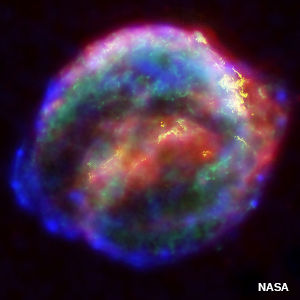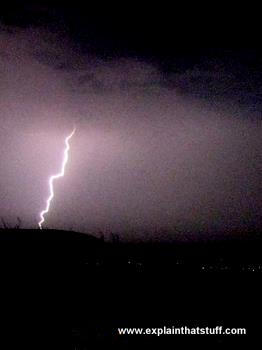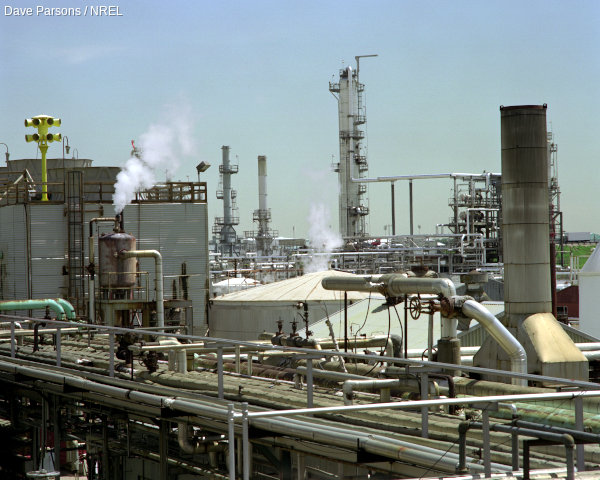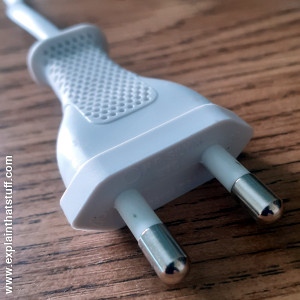
Energy
by Chris Woodford. Last updated: April 11, 2024.
Try to think of something that doesn't involve energy and you won't get very far. Even thinking—even thinking about energy!—needs some energy to make it happen. In fact, everything that happens in the world uses energy of one kind or another. But what exactly is energy?
Energy is a bit of a mystery. Most of the time we can't see it, yet it is everywhere around us. Revving car engines burn energy, hot cups of coffee hold energy, street lights that shine at night are using energy, sleeping dogs are using energy too—absolutely everything you can think of is using energy in one way or another. Energy is a magical thing that makes other things happen. Everything in the world is either energy or matter ("stuff" around us) and even matter, when you really get down to it, is a kind of energy!
Picture: A supernova is the remains of an exploding star and it's just about the most spectacular release of energy you can get. This particular one is a gigantic explosion of dusty gas 14 light-years across (roughly 132 billion kilometers) and booming outward at 2,000 km per second (or 4 million mph). Composite photo of Kepler's Supernova courtesy of NASA/ESA/JHU/R.Sankrit & W.Blair, and NASA Chandra X-Ray Observatory.
Sponsored links
Contents
Potential energy and kinetic energy
Although there are many kinds of energy in the world, they all fall into two broad categories: potential energy and kinetic energy. When energy is stored up and waiting to do things, we call it potential energy; "potential" simply means the energy has the ability to do something useful later on. When stored energy is being used to do something, we call it kinetic energy; "kinetic" means movement and, generally, when stored energy is being used up, it is making things move or happen.
It's easy to find examples of both potential energy and kinetic energy in the world around us. If you push a boulder up a hill, you'll find it's a real effort to get to the top. This is because the force of gravity is constantly trying to pull you (and the boulder) back down. In science, we say you have to do work against the force of gravity to push the boulder up the hill. Doing work means you have to use energy: the muscles in your body have to convert sugar and fat to make the energy you need to push the boulder. Where does this energy go? Although you use energy as you climb, your body and the boulder also gain energy—potential energy. When the boulder is at the top of the hill, you can let it go so it rolls back down again. It can roll down because it has stored potential energy. In other words, it has the potential to roll down the hill all by itself.

Artwork: You have to "do work" against the force of gravity when you push a boulder up a hill and lose energy as you do so; the boulder gains this "potential" energy as it climbs.
As the boulder starts to roll down the hill, the potential energy it had at the top is gradually converted into kinetic energy. When we talk about kinetic energy, we usually mean the energy something has because it is moving. Anything that has mass (contains some matter that takes up a volume) and moves along at a certain velocity (or speed) has kinetic energy. The more mass something has and the faster it goes (the higher the velocity), the more kinetic energy it has. If a truck and a car are driving parallel to one another down the freeway, at the same speed, the truck has more kinetic energy than the car because it has much more mass. (Read more about the science of motion.)
A lot of things we do each day involve converting energy between potential and kinetic. Pull yourself up a cliff on a rope and you have more potential energy the higher you go up. If you abseil down, your potential energy is converted into kinetic energy as you move. By the time you reach the bottom, the kinetic energy has turned to heat (your climbing equipment and the rope will get surprisingly hot) and sound (the rope will make a noise as you whiz down).

Artwork: You gain potential energy every time you walk up stairs. Your muscles pull your body against the force of gravity, doing work. In theory, the potential energy your body gains as you climb is exactly the same as the food energy it loses: one form of energy is simply converted into another. (In practice, you need to use more energy than you might think because your body wastes quite a lot of energy in the process.) At the top of a flight of stairs, you could turn your stored potential energy back into kinetic energy (movement) in various ways, such as sliding down the banisters or jumping down a fireman's pole! You can trace every bit of energy your body uses back to the food you eat, which comes from animals and plants and ultimately from the Sun.
Other kinds of potential and kinetic energy

Photo: Now that's what I call kinetic energy! A spacecraft travels at something like 40,000 km/h (25,000 mph or 11,000 m/s) as it re-enters Earth's orbit. Assuming it weighs about 30,000 kg, then, according to my calculations, it has enough energy to power an electric toaster constantly for about 30 years! Picture of Apollo 8 taken in 1968 by US Air Force courtesy of NASA on the Commons.
Things can have potential and kinetic energy for other reasons. Here are some more examples. A thundercloud passing overhead has "the potential" to release electrical energy as huge bolts of lightning. In other words, we say it has electrical potential energy. Suppose you want to fire an arrow from a bow. When you pull back the elastic bowstring, you have to stretch it well beyond its natural shape. As you do this, you give it what's known as elastic potential energy (it is sometimes also called mechanical potential energy). When you release the bowstring, it uses the stored potential energy to fire the arrow through the air.

Photo: A bow and arrow converts elastic potential energy (stored in the bow) into kinetic energy (in the shooting arrow). Photo by Robert A. Whetstone courtesy of US Army and DVIDS.
Just as there are several kinds of potential energy, so there are different kinds of kinetic energy too. When a thundercloud releases its electrical potential energy as lightning, giant sparks fly from the sky to the ground. A bolt of lightning is a huge electric current (flow of electricity) moving through the air—in other words, it is what we might refer to as "electrical kinetic energy". We can also think of sound, heat, and light as examples of kinetic energy because they involve energy moving from one place to another.

Photo: Lightning is a huge release of electrical potential energy.
Heat energy
Heat is one of the most familiar kinds of energy in our world—but is it potential energy or kinetic energy? Actually, it can be both. Suppose you heat an iron bar in a fire so it glows red hot. If you plunge it into a bucketful of cold water, you'll make a huge amount of steam. The energy from the hot bar goes into the water and heats that up too, losing some of its own energy in the process. This means that a hot bar—a bar with heat energy—has potential energy: it has the potential to heat something else up.
But a hot bar also has kinetic energy. Inside an iron bar, there are billions of iron atoms held together in a rigid structure called a crystal lattice. It's a bit like a climbing frame with atoms at the joints. Although the atoms are pretty much fixed in the same place, they are constantly jiggling about. Each atom has a little bit of kinetic energy. The more you heat an iron bar and the hotter it becomes, the more the atoms jiggle about—and the more kinetic energy they have. In other words, heat is held inside the bar by the jiggling atoms and their kinetic energy. The idea that heat is caused by atoms and molecules moving around is known as the kinetic theory of matter.
Hot objects like to pass their heat energy to other things nearby. If you touch something hot, some of its heat energy flows into you—and you get burned. This is called heat conduction. But you don't have to touch something to feel its heat. If you sit some distance from a roaring fire, you'll be able to feel its heat energy on your cheeks even though the flames are not actually touching you. This happens because the fire passes its energy through empty space by a process called heat radiation. Radiation is the way the Sun passes its energy through about 150 million km (93 million miles) of empty space to earth in a journey that takes a little over 8 minutes.
Heat energy also moves in a third way, known as heat convection. If you put a pan of soup on top of the stove and heat it up, heat travels from the stove to the pan by conduction. The soup at the bottom of the pan quickly warms up. This makes it less dense ("thinner") than the soup above it, so it rises upward. As the warm soup rises, it pushes the colder soup at the top out of the way, and the cold soup falls back down to take its place. Pretty soon, there's a kind of invisible loop forming inside the soup, with heat energy constantly being carried up from the stove and circulating through the liquid up above. This process is also how heat travels through a hot air balloon, from the burner at the bottom, so it systematically heats up all the gas inside.
You can read more about this topic in our main article on heat.
Sponsored links
Making and using energy

Photo: The Sun is a blazing red ball of heat energy. Most of our energy comes directly or indirectly from it. Picture courtesy of NASA/GSFC/SDO and NASA on the Commons.
Where does energy come from? Well, if you have a hot cup of coffee sitting on your desk, the heat energy it contains originally came from the hot water you used to make it. The hot water got its energy from the kettle you put on the stove or plugged into the electricity outlet. And where did the electricity come from? Most likely, from a power plant, which burned a fuel such as gas, coal, or oil to release the energy it contained. But where did the energy in that fuel come from originally?
You can play this energy game forever, tracing energy from one thing to another—all the way back to its original source. Wherever you start from and however you go, you pretty much always end up at the same point: the Sun. This giant fireball in space provides over 99 percent of the energy we use on earth. You may think solar power is futuristic and impractical, but in fact the world has been solar powered ever since it was created. Playing the energy game reveals something else as well: we can never actually create energy or destroy it. Instead, all we can do is convert it from one form to another. This idea, which is one of the most basic laws of physics, is known as the conservation of energy.
The energy we use in our daily lives falls into three broad categories: the food we eat to keep our bodies going, the energy we use in our homes, and the fuel we put in our vehicles. The food we eat comes from plants and animals, which our stomachs digest to make a sugary substance called glucose that blood transports around our bodies to power our muscles. All animals ultimately get their energy from plants, which are themselves powered by sunlight. Plants are like living solar panels that absorb the Sun's energy and convert it into food. The energy we use in our homes tends to be provided by coal, gas, and oil. These three "fossil fuels" are underground supplies of energy, created millions of years ago, that we drill, mine, or pipe to the surface to satisfy our energy needs today. Most of the energy we use in our vehicles also comes from oil. The trouble with fossil fuels is that we are using them much more quickly than we are creating them. Another problem is that burning fossil fuels creates a gas called carbon dioxide that is building up in Earth's atmosphere and causing a problem known as global warming (climate change).

Photo: Plants are like living solar panels. It's amazing to think that nature produced something that can automatically capture and store solar energy in a very efficient way—something that the world's best scientists and engineers are still struggling to do!
Electricity—the best kind of energy?
Fossil fuels such as oil, gas, and coal have been enormously helpful to humankind's economic development. Coal powered the industrial revolution in the 18th and 19th centuries, while oil made possible a huge growth in personal transportation following the invention of the internal combustion engine. Natural gas, a much cleaner and more efficient fuel, has become an increasingly important source of power since the mid-20th-century. Yet all these fuels have their drawbacks. Coal is dirty and inefficient. Oil exists in limited supplies in places such as the Middle East and growing demand for it is a major source of world tensions and wars. Gas, though easy to move from place to place, can be dangerous when it leaks or escapes. Turning coal, gas, oil and other fuels into electricity is a way to make them much more versatile and useful.
Electricity is a kind of energy usually made in power plants by burning fuels. According to the US EIA, about 60 percent of the electricity made in the United States comes from burning gas (43.1 percent), coal (16.2 percent), and oil (0.4 percent). Inside a power plant, fuel is burned in a huge furnace to release the energy it contains as heat. The heat is used to boil water and produce steam, which turns a rotating propeller-like mechanism called a turbine. The turbine is connected to an electricity maker or generator, which produces electricity as the turbine spins it around.
The great thing about electricity is that it is so versatile. Almost any kind of fuel can be turned into electricity. Once electricity has been made in a power plant, it is easy to transmit from one place to another either overground or underground along cables. Inside homes, factories, and offices, electricity is turned back into other kinds of energy by a wide range of appliances. If you have an electrical stove or toaster, it takes electricity supplied by a power plant and converts it back into heat energy for cooking food. The lights in your home convert electrical energy into light energy (and, unless you are using energy-efficient light bulbs, quite a lot of heat). Your stereo or MP3 player turns electricity back into light, while your cellphone (mobile phone) uses it to make radio waves.
Energy future

Photo: Petroleum refineries like this may shut down in future as oil supplies start to run dry. Picture by David Parsons courtesy of National Renewable Energy Laboratory (NREL).
According to the US EIA, world energy use could grow by 50 percent (half as much again) between 2020 and 2050. Around 82 percent of the energy we use on Earth today comes from fossil fuels, [1] but that cannot continue much longer. Fossil fuels will run out sooner or later and, even if they last longer than expected, they could make global warming run out of control.
Fortunately, because much of the power we use comes from electricity, we have alternatives. We can make electricity from wind power, for example, or solar panels. We can incinerate trash to generate heat that will drive a power station (though at the risk of producing air pollution). We can grow so-called "energy crops" (biomass) to burn in our power stations instead of fossil fuels. And we can harness the huge reserves of heat trapped inside Earth, known as geothermal energy. Together, these energy sources are known as renewable energy, because they will last forever (or, at least as long as the Sun keeps shining) without running out. Earth's supplies of renewable energy are vast. A 3m (10ft) high ocean wave has enough power per meter (3.3ft) of its width to power 1000 light bulbs. [2] If we could cover just one percent of the Sahara Desert with solar panels (an area slightly smaller than the United States), we could make more than enough electricity for our entire planet. [3]

Photo: In the future, we'll need to get better at using renewable energy sources, such as Earth's internal heat (geothermal energy). Picture by Carol M. Highsmith, courtesy of Gates Frontiers Fund Wyoming Collection within the Carol M. Highsmith Archive, Library of Congress, Prints and Photographs Division..
We'll also need to be smarter in the way we use energy. By designing machines and appliances that do the same jobs but use less power, we can make the energy we have go much further. This is called energy efficiency (saving energy) and it's like a completely free way of making power. Energy companies often find it cheaper to give away thousands of energy-efficient light bulbs than build new power plants.
What about cars? In the future, most of our vehicles will be powered by electricity from onboard batteries or battery-like devices called fuel cells, which use hydrogen gas to generate electricity and power electric motors. Electric vehicles first became popular in places like California and are now finally taking off worldwide. Hybrid vehicles are also helping to make oil go further. Unlike a conventional car, a hybrid car has two "engines": one of them, a standard petrol engine, is used for high-speed driving—down the freeway, for example; the other, a compact electric motor, powers the car cleanly, quietly, and efficiently in cities.
Today, most of our electricity comes from far-off power plants transmitted down huge lengths of cable. It takes energy to move energy from one place to another. Making electricity in remote power plants and transmitting it down wires wastes around two thirds of its energy. In other words, if you burn three tons of coal in a power plant, you waste two tons of it getting the energy out of the coal, making electricity, and transmitting the electric power to customers. This is why buildings of the future are likely to make more of their own local power, for example, with solar panels, community wind turbines, or heat pumps that "suck" stored energy from the ground beneath out feet.
Each second, the Sun sends out more power than all the energy people on Earth would use in about three quarters of a million years. [4] Not all of this energy reaches our planet and it's not all in a form we can capture. But if we think about the energy we use, and use it more wisely, there's no reason why we should ever run out—or why we should spoil our planet for tomorrow's children when we make the energy we use today.








